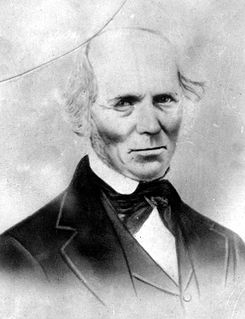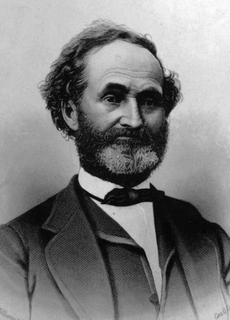
Lorenzo Snow was an American religious leader who served as the fifth president of The Church of Jesus Christ of Latter-day Saints from 1898 until his death. Snow was the last president of the LDS Church in the 19th century and the first in the 20th.

Pioneer Day is an official holiday celebrated on July 24 in the American state of Utah, with some celebrations taking place in regions of surrounding states originally settled by Mormon pioneers. It commemorates the entry of Brigham Young and the first group of Mormon pioneers into the Salt Lake Valley on July 24, 1847, where the Latter-day Saints settled after being forced from Nauvoo, Illinois, and other locations in the eastern United States. Parades, fireworks, rodeos, and other festivities help commemorate the event. Similar to July 4, many local and all state-run government offices and many businesses are closed on Pioneer Day.

The Mormon pioneers were members of The Church of Jesus Christ of Latter-day Saints, also known as Latter-day Saints, who migrated beginning in the mid-1840s across the United States from the Midwest to the Salt Lake Valley in what is today the U.S. state of Utah. At the time of the planning of the exodus in 1846, the territory was part of the Republic of Mexico, with which the U.S. soon went to war over a border dispute left unresolved after the annexation of Texas. The Salt Lake Valley became American territory as a result of this war.

Jonathan Browning was an American inventor and gunsmith.
The Nauvoo Brass Band was an official musical organization of the Church of Jesus Christ of Latter Day Saints when the church's headquarters were located in Nauvoo, Illinois. It was later revived by The Church of Jesus Christ of Latter-day Saints in the Utah Territory.

Joseph Toronto was the first Italian convert to the Latter Day Saint movement and was one of the first missionaries of The Church of Jesus Christ of Latter-day Saints in Italy.

Reynolds Cahoon was an early leader in Latter Day Saint movement and later, in The Church of Jesus Christ of Latter-day Saints. He was one of the inaugural members of the Council of Fifty, organized by Joseph Smith in 1844.

Chauncey Walker West was a Mormon pioneer and was a leader of The Church of Jesus Christ of Latter-day Saints in Utah Territory. He was among the church's first missionaries to preach in Sri Lanka.

John Pack was a member of the Council of Fifty and a missionary in the early days of The Church of Jesus Christ of Latter-day Saints.

Edwin Dilworth Woolley, Sr. was a Mormon pioneer, an early Latter-day Saint bishop in Salt Lake City, and a businessman in early Utah Territory who operated mills.

Alexander Neibaur was the first dentist to practice in Utah and first Jew to join the Latter Day Saint movement. He was educated for the profession at the University of Berlin and was a skilled dentist before the establishment of dental schools in America. He was fluent in 7 languages and as many dialects.

Lorin Farr was a Mormon pioneer and the first mayor of Ogden, Utah.
Charles Root Dana was an American Mormon leader, pioneer, and missionary, and a politician in territorial Utah.
Vinson Knight was an early leader in the Latter Day Saint movement. He served as a counselor in the bishopric in Kirtland, Ohio, from 1835 to 1838, then as bishop in Adam-ondi-Ahman in Daviess County, Missouri, from 1838 to 1839, and finally as bishop of the Lower Ward in Nauvoo, Illinois, having been called by Joseph Smith through revelation to that office in January 1841. Knight served as bishop in Nauvoo until his sudden death at age 38.
The Belnap Family Organization is a non-profit ancestral family organization that conducts primary genealogical research and preserves genealogical and other historical information on the Belnap/Belknap family surname, including the descendants of Mormon Pioneer Gilbert Belnap (1821–1899) and his plural wives Adaline Knight (1831–1919) and Henrietta McBride (1821–1899). According to its mission statement, the organization exists "to preserve, perpetuate, and promote family solidarity." It is one of the oldest and largest ancestral family organizations in existence, having been established in Utah in 1904.

Martha McBride Knight Smith Kimball was a founding member of the Relief Society of the Church of Jesus Christ of Latter Day Saints, which was organized on her birthday in 1842. She was married to early Latter Day Saint leader Vinson Knight, by whom she had seven children. In 1842 she was sealed as a plural wife to Joseph Smith. In January 1846, she was married polygamously to Heber C. Kimball, by whom she had one child, a son, who was born at Winter Quarters and died there as an infant. She later emigrated to Utah Territory, where she resided in various locations across the territory until her death at age 96. She was a witness to, and in some instances a key participant in, some of the pivotal events in early Latter Day Saint history.

Arias Guy Belnap was a Utah politician and businessman.

Lewis Warren Shurtliff was a Utah politician and a missionary and leader in The Church of Jesus Christ of Latter-day Saints.
Martin Henderson Harris was a Mormon pioneer, LDS Church leader, early Utah horticulturalist, and early colonizer of Harrisville, Utah and Fort Lemhi, Idaho.
Mary Field Garner was an immigrant to the United States from England. She was a member of The Church of Jesus Christ of Latter-day Saints and a Mormon pioneer.














